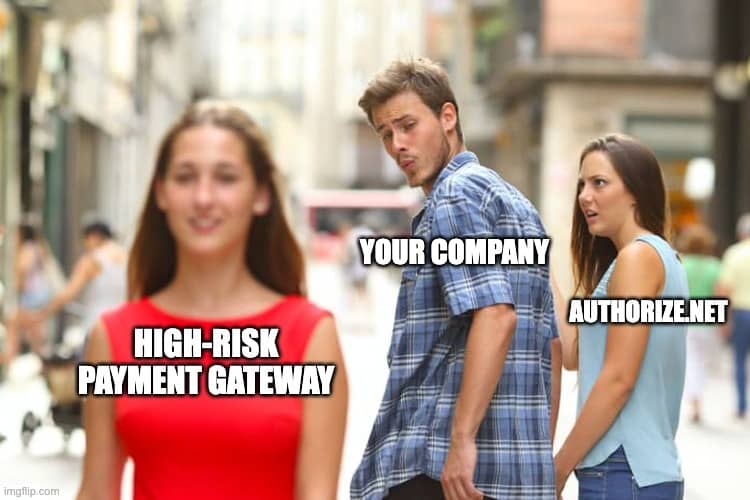Payment Gateway vs. Payment Processor

The Baymard Institute compiled research from 46 studies conducted between February 2012 and November 2021. The institute found that online shoppers abandon their shopping carts nearly 70% of the time. Would you believe your payment gateway could be why your shoppers depart without making a purchase?
You might even think, “Don’t you mean my payment processor?”
However, payment gateway and payment processor aren’t interchangeable terms. These two tools are both responsible for facilitating credit card payments; however, they perform separate but equally important functions of their own.
Do you need a new credit card payment processor or high-risk payment gateway? Zenti has your back.
What’s a payment gateway?
Payment gateways act as the connection between banks, credit card companies, and the payment processor. A payment gateway sends information about the transaction, such as credit card information and total transaction price, virtually over the internet using a payment service and API connections or at a credit card terminal when shopping in-store.
Payment gateways are the heart of credit card processing and can authorize various types of online payment transactions, such as card-present and card-not-present transactions, funds transfers from your checking account to your savings account using an app on your phone. A payment gateway can also facilitate multiple payment methods, such as credit cards, debit cards, digital wallet acceptance, and payments over the Unified Payment Interface (UPI).
Any eCommerce business needs a payment gateway for accepting payments and facilitating online purchases. A physical store location that wants to accept credit and debit cards must also have a payment gateway.
Today’s payment gateways are enhanced with security essentials, such as:
- Chargeback management
- Address verification
- Fraud prevention
- EMV chip-reader with CVV card authentication
- PCI DSS-compliant technology
Depending on your merchant account services provider, your payment gateway may facilitate international payment acceptance. With international payments enabled, you can open your online store to the entire world.
So, if a payment gateway sends payment information, what’s a payment processor? And what’s its role in the life of a transaction?
What’s a payment processor?
Think of the payment processor as the catcher on the baseball field of credit card transactions. The payment gateway is the pitcher. Businesses use payment processors to “catch” the credit card data “pitched” to them from the payment gateway. The payment processor receives the card and transaction information and tosses it to the credit card issuer. The data is tossed back and forth between the payment’s players until the transaction is completed (a more in-depth breakdown of this process is in the next section).
Businesses need a payment gateway and payment processor to complete credit card payment transactions. Some payments companies integrate payment processors into native hardware, such as credit card readers, point of sale (POS) systems, and POS terminals, as well as into native software, such as customer relationship management (CRM) programs. Other payment companies focus solely on the payment itself. The right payment processor for your business depends on your average transaction volume and payment acceptance method(s).
How do payments work? What are the steps in the process?
Every transaction has four parties, or six key aspects, overall:
- The customer
- The store owner or merchant
- The payment gateway and payment processor facilitate the transaction
- The card issuing bank à Issued the customer’s credit card
- The acquiring bank à Receives the funds from the customer’s credit card for payment
There are several “pings,” so to speak, that travel from the payment gateway to the payment processor and between the banks and the payment processor until the payment processor returns a message to the payment gateway’s keypad screen that shows approvals or declines.
The entire process takes just seconds, thanks to the speed of today’s internet technology.
When the transaction occurs online, the steps are pretty much the same. But rather than the customer physically swiping their credit or debit card at the credit card machine, the customer is directed to a checkout page. This is the payment gateway in an online transaction. The customer enters the credit card (or, at some online merchants, bank account) information which the gateway encrypts prior to sending it on to the payment processor. During this process, the payment gateway is also checking the card information for any security issues, such as a card reported lost or stolen. Transport Layer Security (TLS) is built into the payment gateway to ensure fraudulent or stolen credit cards can’t be used as payment. When everything checks out, the gateway sends the information to the card-issuing bank.
The issuing bank ensures the connection is safe, then checks the customer’s account to ensure sufficient funds for the purchase and responds to the payment processor with authorization. With the authorization, the payment processor pings the store’s merchant account to approve the purchase. The acquiring bank accepts the payment, which is placed into the merchant account. The customer receives notification that their purchase is approved and the transaction is settled.
Now, at any point during the transaction, the merchant account has the right to deny the purchase. If this happens, the website will provide an alert asking the customer to pay with a different card or bank account.
Usually, this happens because the customer’s card has insufficient funds for the transaction. However, less frequently, a Declined message can result from a network error, a bank-related problem, or the store itself may be close to or at its merchant account transaction limit for that period.
Once the transaction is finalized, the merchant may have immediate access to the funds or may have to wait a few business days. This can depend on the terms of the store’s merchant account, the type of merchant account the store has, or the account the customer used for the transaction. Transactions using bank account information typically aren’t processed until the next day; if it’s a weekend, funds may not be available until the following week. With Zenti’s transparent payment processing solutions, never wonder if your sales proceeds are tied up.
Payment gateway vs. payment processor: What’s the difference?
Let’s look back at that baseball-reference. During a baseball game, unless there’s a major upset at home plate, a line drive out to the center field, or someone hits a home run with bases loaded, the players don’t move too far from their positions:
- The pitcher stays on the pitcher’s mound
- The catcher stays behind home plate
- 1st, 2nd, and 3rd basemen all stay pretty near their bases
- And the fans (usually) remain in their seats.
Here’s how this analogy applies to payment processing:
- Pitcher: The payment gateway. Takes information from the customer’s credit card, encrypts the data, and “pitches” it to the payment processor.
- Catcher: The payment processor. “Catches” the encrypted data package and simultaneously fields and throws the ball to each of the “basemen.”
- Basemen: Merchant, acquiring bank, card issuing bank. The payment processor is like a “gatekeeper” for the payment gateway. While facilitating the ball game, the payment processor ensures the ball (of encrypted data) remains secure from the moment the “baseball fan” (the customer) initiates and approves the purchase until the funds have been transferred into the merchant’s bank account.
Payment processors also usually provide merchants with equipment for payment acceptance, such as a credit card machine. But the most important thing aside from the machine for processing is that the merchant must have a merchant account and merchant services, provider. Zenti’s zero-cost payment processing helps businesses keep customers happy with uninterrupted payment services.
At a physical store, payments are accepted via the payment terminal or point-of-sale (POS) machine.
Are there different types of payment gateways?
Since the payment gateway is really the star of the credit card payment processing show, it’s good to know what types exist and which type might work best for your business.
Redirect payment gateway
This payment gateway offers the easiest, most streamlined payment experience. Redirect works best for businesses that have just opened and smaller businesses that might not have the resources to obtain an actual merchant account. A redirect payment gateway has robust security features, offers easy setup, and doesn’t require a merchant account for configuration.
This type of payment gateway is perfect for online retailers, as the system guides your customers to a different page to finalize the transaction. These checkout pages are customizable, so you can add your business information, such as operating hours and locations (if you have physical stores), and your business logo.
A redirect payment gateway takes the guesswork out of processing payments. Security tools and privacy policies are built into the gateway. The only disadvantage of this type of gateway is that if you like being in control and monitoring each step of your business processes, you may not like the lack of control users have. Finally, another drawback to a redirect is that it halts the shopper’s experience to finish payment, navigating them away from your site.
Onsite checkout with offsite payment gateway
Unlike the redirect, this payment gateway keeps customers onsite to complete the checkout process. This is more streamlined and easier to navigate for your customers.
But transactions are completed offsite. Now, the benefit of the redirect payment gateway is that all security and privacy tools are built into the gateway. With the onsite checkout/offsite payment gateway, you must ensure your customers’ privacy and data are protected. In other words, PCI DSS compliance is solely your responsibility.
Onsite payment gateway
The fully onsite payment gateway is perfect if your online business is rather large and processes high transaction volume. Cart validation, checkout, and payment all appear to happen right on your store’s website. This is good because most consumers don’t like being redirected elsewhere on the web to complete a transaction.
However, behind the scenes, a connected gateway provided by a third-party temporarily takes your customers offsite to complete the transaction. Customers won’t notice a thing because the payment gateway page looks no different than your website.
While the customer is awaiting payment finalization, you can use the opportunity to present upcoming sales or push add-on sales to boost revenue.
After the payment is complete, the background system automatically sends customers back to your site, right where they left off. So, customers get to continue browsing, potentially leading to increased sales.
This is the fastest payment gateway technology for online shoppers. The system is not only fast, but it’s also secure and reliable with negligible to no downtime. That’s the good news.
The bad news is the build is rather complicated. If you have no coding or developer knowledge, you’ll have to hire someone who does just to set up the gateway. Additionally, there aren’t any internal security certificates. You must obtain PCI DSS compliance with proof and get a Secure Sockets Layer (SSL) certificate to verify the website and install security protocols.
What matters most when it comes to payment processors?
Choosing a payment processor and merchant account provider can be almost as intimidating as finding the right payment gateway. For many business owners, it eventually boils down to, “How much can I afford?”
Payment processors usually offer at least these three typical fee schedules:
- Interchange-plus: Consists of the current interchange rate plus an additional markup percentage.
- Flat rate: One flat rate is imposed across all transactions, whether 5 USD or 500 USD.
- Tiered packages: A scaling fee schedule that flexes with your transaction volume.
When reviewing payment processors, think about the following:
- What is the payment processor’s fee schedule?
- Is the fee schedule sensible for your business?
- Does the payment processor have good reviews online?
It’s important that a payment processor is honest and transparent regarding all fees you’re responsible for.
Partner with Zenti
You have enough on your plate running a business. Security certificates and privacy policy compliance shouldn’t be worries you have to think about daily. Let Zenti help. With low- to zero-cost payment processing options, Zenti is the high-risk merchant account that has your back. Reach out to us and speak with one of our expert payment solutions specialists today.
Read Next

Find out whether Authorize.Net works for high risk merchants, what restrictions you might face and how to get approved.

Get expert advice on selling CBD products on Shopify, including compliance tips and setting up secure payment options.

Find out why Square may deactivate merchant accounts and steps to resolve issues and maintain uninterrupted payment services.
Need a High-Risk Merchant Account?
Disruption-free payment processing at the best price for your situation, guaranteed.
Get Free Guidance Now!